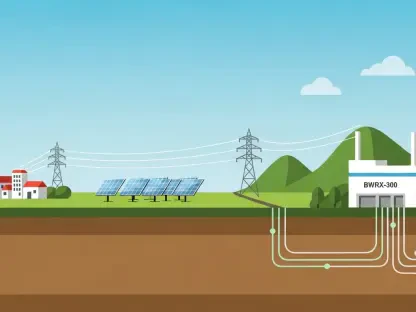In a landscape where energy costs continue to challenge public institutions, a staggering £100 million investment by Great British Energy (GB Energy) to install solar photovoltaic (PV) systems at 255 schools across England marks a pivotal shift. This bold initiative not only addresses the pressing financial burdens faced by educational facilities but also positions the UK education sector at the forefront of the renewable energy transition. With energy bills often consuming significant portions of school budgets, this move promises to redirect savings into critical resources, while simultaneously fostering a culture of sustainability among students.
The purpose of this market analysis is to dissect the implications of GB Energy’s program within the broader context of renewable energy adoption in public infrastructure. It aims to uncover how this investment influences market trends, shapes economic dynamics, and sets a precedent for future scalability. By exploring the financial, social, and workforce dimensions of the initiative, this examination seeks to provide actionable insights for stakeholders in both the energy and education sectors.
This analysis will delve into current market patterns surrounding clean energy in public spaces, evaluate data-driven impacts of solar installations in schools, and project future trajectories for similar investments. From regional equity considerations to workforce development opportunities, the discussion will highlight how this program is reshaping the intersection of energy and education markets. Let’s explore the transformative potential of solar power as a catalyst for change in the UK.
Solar Power in Public Infrastructure: Market Dynamics and Growth
Rising Demand for Renewables in Public Sectors
The UK energy market has witnessed a notable surge in demand for renewable solutions within public infrastructure over recent years, driven by stringent net-zero carbon targets and escalating fossil fuel costs. Government-backed entities like GB Energy are increasingly pivotal, channeling investments into solar and wind projects for schools, hospitals, and civic buildings. The £100 million commitment to 255 schools exemplifies a growing trend where public sector decarbonization is not just a policy goal but a strategic market opportunity for energy providers and technology firms.
This trend is underpinned by a critical need to alleviate financial pressures on public institutions. Schools, often constrained by limited budgets, have historically struggled with energy expenses that divert funds from educational priorities. The current push by GB Energy builds on smaller-scale successes, such as the initial solar PV installations at 23 schools with a capacity of 526kW, demonstrating a scalable model that attracts further investment from both public and private sectors into renewable infrastructure.
A key driver in this market shift is the evolving regulatory landscape, which incentivizes clean energy adoption through grants and subsidies. As policies align more closely with sustainability goals, the market for solar PV systems in public spaces is expected to expand, creating a ripple effect for suppliers, contractors, and maintenance services. This dynamic positions the education sector as a testing ground for innovative energy solutions, potentially influencing broader adoption across other public domains.
Financial Impacts and Market Opportunities
Drilling down into the financial implications, GB Energy’s investment offers a dual market impact: immediate cost relief for schools and long-term opportunities for energy sector players. With schools projected to save significant sums—evidenced by a 9.4% reduction in energy consumption at certain London trusts, equating to £299,000 in savings—these funds can be reinvested into educational resources, indirectly boosting markets for technology and learning materials.
For energy companies, this initiative signals a burgeoning niche in public sector solar installations. The program’s expansion from an initial £80 million to £100 million reflects growing confidence in the return on investment for renewable projects. Suppliers of solar panels, installation services, and energy management systems stand to gain as demand spikes, while the need for ongoing maintenance contracts opens a steady revenue stream. However, market entrants must navigate challenges such as high upfront costs and ensuring system longevity to maintain competitiveness.
Beyond direct financial benefits, the ripple effect on local economies cannot be ignored. Schools saving on energy bills contribute to regional economic stability by sustaining budgets for staff and services, which in turn supports ancillary markets like educational publishing and IT solutions. This interconnected growth highlights how targeted energy investments can stimulate broader economic activity, positioning renewables as a cornerstone of public sector financial strategy.
Regional Equity and Market Segmentation
A distinctive feature of GB Energy’s approach is its focus on regional equity, mandating that at least 10 schools per region in England receive funding, with priority given to deprived areas. This strategy not only addresses social disparities but also segments the market by geographic and socioeconomic need, creating tailored opportunities for energy providers to cater to diverse local conditions. Such segmentation allows for customized solutions, like adapting solar systems to varying sunlight exposure or energy demands across regions.
This equity-driven model also influences market competition by encouraging localized partnerships between energy firms and regional authorities. Companies that can offer flexible, community-specific solutions are likely to gain a competitive edge, as opposed to one-size-fits-all approaches. However, disparities in regional infrastructure and technical expertise could pose barriers, potentially slowing deployment in less equipped areas and affecting market penetration for smaller providers.
From a market perspective, this focus on underserved communities taps into an often-overlooked segment, driving social impact alongside profitability. It sets a precedent for future energy investments to prioritize equity, potentially reshaping how renewable markets define value. As this trend gains traction, expect an increase in public-private collaborations that blend government funding with localized innovation to maximize both reach and impact.
Workforce Development: A New Market Frontier
Clean Energy Jobs and Educational Synergies
An emerging market frontier tied to GB Energy’s initiative is the development of a clean energy workforce through educational partnerships. Further education colleges in regions with solar installations are aligning with contractors to promote careers in renewables, directly feeding into the government’s broader Clean Energy Jobs Plan. The establishment of five Clean Energy Technical Excellence Colleges underscores a strategic effort to build a skilled labor pool, creating a pipeline of talent for the renewable sector.
This initiative opens a significant market for training providers, vocational programs, and educational consultants who can design curricula focused on green technologies. As demand for solar technicians, energy auditors, and sustainability specialists rises, these educational synergies position the UK to address labor shortages in the renewable sector. Market projections suggest steady growth in job creation, with ancillary opportunities for career counseling and certification bodies to support this transition.
The integration of sustainability into school curricula, such as through new qualifications like a Natural History GCSE, further amplifies market potential by fostering early interest in green careers. This long-term approach not only builds consumer awareness for renewable solutions but also ensures a future workforce that values sustainability, creating a virtuous cycle of demand and supply in the clean energy market. Companies investing in educational outreach now could secure brand loyalty among the next generation of professionals.
Challenges and Market Gaps in Workforce Readiness
Despite the promising outlook, the market for clean energy workforce development faces notable challenges. Regional disparities in access to training infrastructure mean that some areas may lag in producing qualified workers, creating uneven market growth. Energy firms and educational institutions must address these gaps by investing in mobile training units or digital learning platforms to ensure broader accessibility.
Another market hurdle is the perception barrier surrounding renewable careers, where potential entrants might view these roles as niche or inaccessible. Marketing campaigns and outreach programs by industry stakeholders can help demystify these opportunities, highlighting diverse entry points and career progression paths. Failure to address this could result in a talent shortfall, slowing the pace of renewable project deployment and impacting market expansion.
Additionally, the speed of technological advancement in renewables necessitates continuous upskilling, creating a sustained demand for professional development services. Training providers who can offer agile, updated programs will likely dominate this sub-market. As GB Energy’s projects scale, the interplay between workforce readiness and project demand will be a critical factor in determining the long-term sustainability of the renewable energy market in public infrastructure.
Future Projections: Scaling Clean Energy in Education and Beyond
Looking ahead, the trajectory of GB Energy’s solar initiative points to a robust expansion of clean energy markets within the education sector and potentially other public arenas. Innovations like advanced energy storage and smart grid integration are poised to enhance the efficiency of school-based solar systems, driving down costs and increasing appeal for investors. Market forecasts indicate a growing appetite for such technologies, with suppliers likely to see heightened demand as schools seek to maximize energy independence.
Economic and policy shifts will further shape this landscape, with anticipated increases in government incentives for renewable adoption. Potential adjustments in energy pricing structures could make solar investments even more attractive, encouraging schools and other public entities to join the transition. Analysts predict a rise in public-private partnerships, blending state funding with corporate innovation to accelerate project rollouts and expand market reach across diverse sectors.
Speculatively, the cultural impact of embedding clean energy in schools could redefine market dynamics over the long term. As students grow up surrounded by sustainable solutions, societal demand for green technologies may surge, influencing consumer markets beyond infrastructure. This generational shift could position the UK as a leader in renewable adoption, with the education sector serving as a springboard for broader market transformation in the years from 2025 to 2030.
Reflecting on Market Insights and Strategic Pathways
Reflecting on the analysis, GB Energy’s £100 million investment in solar power for 255 UK schools emerges as a landmark move that reshapes market trends at the intersection of energy and education. The initiative not only alleviates financial pressures on schools but also catalyzes growth opportunities for renewable energy providers, training institutions, and ancillary markets. Its emphasis on regional equity and workforce development further underscores a multi-dimensional approach that balances profitability with social impact.
Strategically, stakeholders in the energy sector are encouraged to focus on localized solutions and partnerships to capitalize on regional market segments. Educational institutions and policymakers find value in integrating sustainability into curricula and career pathways, ensuring a steady talent pipeline for the green economy. Energy firms and service providers should adapt by addressing workforce readiness gaps through innovative training models and outreach.
Looking back, the most critical takeaway is the potential for scalability—extending similar programs to other public spaces like libraries and community centers. Future considerations include leveraging emerging technologies to enhance project efficiency and advocating for policy frameworks that sustain long-term investment in clean energy. This initiative lays a robust foundation, offering a blueprint for how targeted public funding can drive market innovation and societal progress in tandem.









